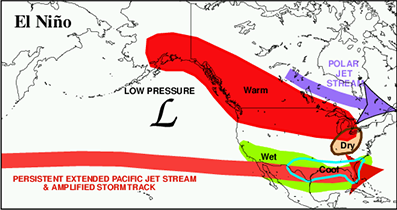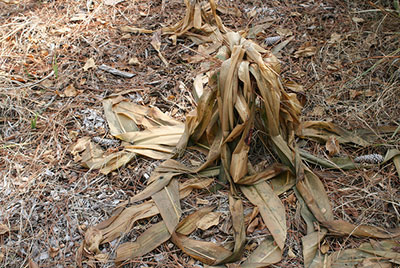El Niño

Typical January-March weather pattern during an El Niño event.
Source: National Oceanic and Atmospheric Administration
You may have heard reports that we’re in an El Niño year, or experiencing an El Niño event. However, you may not know what exactly El Niño is or how it will effect South Florida gardening.
It’s a weather pattern that occurs when surface water temperatures rise in the Pacific Ocean to above-average levels. El Niño weather events generally mean that the southeastern United States is in for a cooler, wetter winter and spring (as opposed to a La Niña year, where we experience a warmer and dryer winter). These patterns occur every two to seven years.
While it is important to know what causes these events, as a gardener you’re probably more concerned with what exactly an El Niño year means for your plants.
For one, a wetter winter means that you could see an increase in plant disease and fungal problems, as the conditions will be favorable for their development. Keep a close eye on your garden so that you can quickly catch any issues that may arise before they become a major problem. Additionally, with more rain comes increased soil erosion and stormwater runoff. Rains can also leach nutrients from the soil, particularly nitrogen, so be on the lookout for nutrient deficiencies in your plants.
The increase in rain, coupled with cooler temperatures, could also slow the development of deciduous fruits. Even increased cloud cover from all the rain can affect the growth of some fruit trees.
Speaking of fruit, keep in mind that strawberries develop slower during El Niño years and can be more at risk for developing fungal diseases. Take care when watering to keep your strawberries as dry as possible to prevent fungal diseases. Harvests of other crops in your garden may also be impacted; expect tomatoes and green peppers to yield less.
An El Niño year is not all bad. While the winter will generally be cooler than average, this does not mean that more hard freezes are likely. Cooler winter temperatures during an El Niño year are actually caused more by the increased cloud cover than south-moving arctic blasts. Another plus—the El Niño pattern generally means a milder hurricane season.
The landscape issues caused by El Niño can be mitigated with some extra vigilance and care especially when dealing with heavy rains.
 Florida is known for its sudden downpours, especially in the summertime. Rain brings needed moisture but can also cause problems in the landscape.
Florida is known for its sudden downpours, especially in the summertime. Rain brings needed moisture but can also cause problems in the landscape.
Heavy rains can damage tender plants, wash away mulch, and erode soil from around plant roots. Injured or dead plant parts should be pruned immediately after a storm to allow the plant to recover.
Too much rain, combined with our warm summer temperatures, creates an ideal environment for bacterial and fungal problems.
Monitor your plants for signs of disease — spots or other discoloration on foliage, as well as rotting or wilting of stems, fruit, or even the whole plant. Black spot on roses and powdery mildew on a wide range of plants can become a problem after weeks of rain. Turfgrass is susceptible to fungal problems like leaf spot and take-all root rot.
If the soil is really saturated after a heavy rain and you’re worried about root rot, help the soil dry out by removing the mulch from around plantings for a few weeks. Take care not to walk on the muddy, wet soil near your plants — this increases compaction, which can in turn hurt plant roots.
Since we can’t control the weather, the best we can do is be proactive, keeping an eye out for problems. Keep fallen leaves and other debris clear to avoid spreading disease. Make sure plants are dry before pruning, as disease can spread easily in water. Wait to fertilize until next season. Fertilizer won’t help your plants recover any faster, and the next heavy rain will wash it right off and into the nearest water body.
Take a good look at your landscape. Are there areas that stay especially wet, even puddling? Consider a planting a rain garden with plants that can handle both wet and dry spells. If drainage is an issue for your soil type, you might want to plant in raised beds. In many parts of Florida, sinkholes are a concern, and heavy rains can show signs of potential sinkholes. Look for fresh exposure or slumping on fence posts, foundations, or trees that result when the ground sinks. Another potential sign is called ponding, when small ponds of rainfall form where water had not collected before.
I hope this article was informative in order to get you through our fall & winter seasons with as few problems as possible. If you need help regarding your landscaping, we at Garden Services are fully licensed & insured to handle all your irrigation, landscaping, lawn maintenance and tree service needs whether it’s a residential, commercial landscaping or homeowner association property. If you ever have any comments or questions, please don’t hesitate to call or email me and I’ll be happy to answer any questions that you might have. Special thanks to UF/IFAS extension for some helpful information provided in this post. Until next month Happy Gardening!
